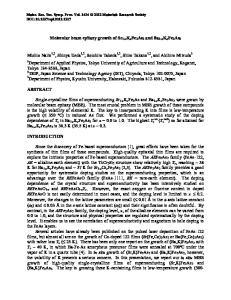The Nature of Superconductivity in Ba 1-x K x BiO 3
- PDF / 472,641 Bytes
- 5 Pages / 604.8 x 806.4 pts Page_size
- 72 Downloads / 308 Views
ULLETIN/JUNE1990
Figure 1. Structure of the cubic superconducting phase of Ba,.xKxBi03.
because of its half-filled band.8 In this respect it is similar to the copper-oxide materials. Since the half-filled band is energetically unstable, the system undergoes a phase transition to an insulating state. In the copper-oxide materials magnetic corrélations split the band, resulting in an antiferromagnetic ground state, while in the bismuth-oxide materials a structural transition occurs, leading to a charge-ordered insulating state. This structural transition, as shown by Cox and Sleight,9-10 results from a correlated rigid rotation and a symmetric breathing mode distortion of the Bi0 6 octahedra. The correlated distortions lead to a monoclinic structure that is a commensurate supercell of the perovskite unit shownjn Figure 1, with cell edges given by V 2 a x V 2 a x 2 a . The breathingmode distortion leads to two inequivalent Bi sites and it is this distortion that opens the gap at the Fermi surface.8This
distortion has been called a "charge disproportionation"9 or, alternatively, can be described as a commensurate "charge density wave." The importance of this distortion is that it results in a semiconducting state. As électrons are removed from BaBi03 by either Pb11 or K12 substitution, the material remains semiconducting until, at some critical doping level, the material becomes "metallic" and at low température shows superconductivity. At this critical composition the material exhibits the highest Tc; Tc decreases at higher doping levels. Figure 2 shows Tc for both K- and Pb-doped BaBi03 as électrons are removed, and shows that Tc decreases as the material is moved from the half-filled condition. Unlike the copper-oxide materials, which show a monotonically increasing carrier concentration of holes as the doping level increases, both Pb- and K-doped BaBi03 remain fully gapped until the critical concentration is reached. At this point the gap collapses and both materials show électron conductivity since the resulting band is less than half filled. Sato13confirmed from Hall and Seebeck coefficient measurements that in the metallic state of the K-doped System the carriers are électrons. The reason the material remains semiconducting in both Pb- and K-doped BaBi03to very high doping levels is still not understood. Figure 3 shows the phase diagram determined recently for the K-doped material.14 As K is added to the system, the breathing mode distortion is rapidly suppressed and the material transforms from the monoclinic (I2/m) to an orthorhombic (Ibmm) structure with the same cell size but containing only one Bi site. In the orthorhombic phase only the rigid tilt of the Bi0 6 octahedra remains. From this average structural information the cause for the insulating state in the orthorhombic structure is not completely understood, since the loss of the breathing-mode distortion should hâve removed the gap. Similar behavior is observed in the Pbdoped system.15 Although superconductivity occurs in a tetragonal structure (with
Data Loading...











